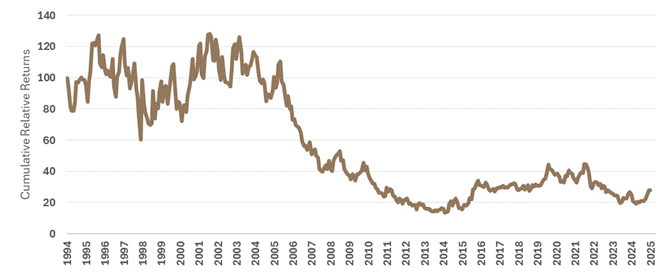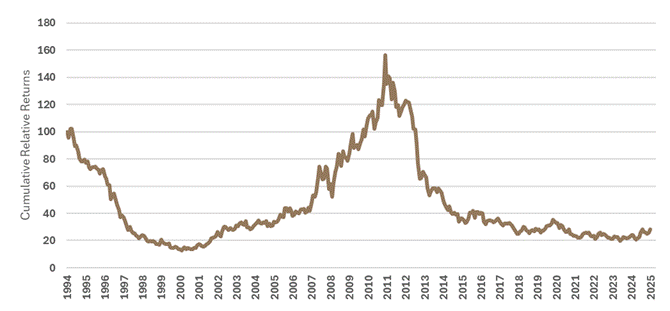Performance Summary
Past performance is not a reliable indicator of future performance
Source: Internal CI data reports, September 30, 2025
Inception Date: 4 July 2002
*Annualised
$100k Invested Since Inception (net)
Past performance is not a reliable indicator of future performance
Source: Internal CI data reports, September 30, 2025
Risk/Return Since Inception (Per Annum)
“Strategy without tactics is the slowest route to victory. Tactics without strategy is the noise before defeat” – Sun Tzu
Quarterly Highlights
The Fund finished below the benchmark during the quarter (Fund up 1.4% vs. S&P/ASX200 up 4.7%)¹.
Underperformers for the quarter included:
- CSL (CSL) - slow growth in the second half of its financial year gave investors cause for concern – see our comments in a later section of this report
- Ramsay Healthcare (RHC) – slower than anticipated progress in the reset of the Australian business as a contract change made a year ago is only now revealed to the market and taking effect, and which is large enough to impact the FY26 result
- QBE Insurance (QBE) – market worries regarding the insurance and interest rate cycles
On the positive side outperformers included:
- Seek (SEK) – showing that it has the ability to contain costs and grow yield on its core products
- Origin Energy (ORG) – result in line with expectations
In addition, we avoided exposure to some results which saw large stocks underperform significantly, including James Hardie (JHX), Woolworths (WOW) and AGL Energy (AGL), and our chemicals/explosives exposure via positions in Orica (ORI) and Dyno Nobel (DNL) worked well.
¹ Past performance is not a reliable indicator of future performance.
Portfolio Insights & Market Observations
Market
The September quarter saw a volatile August reporting season – around a quarter of the stocks that reported had an intra-day share price move of more than 10%.² At a broader market or portfolio level the bumpiness netted out with the index returning a solid 4.7% for the quarter, grinding higher as global economies grew steadily and short-term interest rates trended lower (the RBA lowered the cash rate by a further 25bps during the quarter).
² Source: UBS Research
Despite the ongoing grind higher, some “top-down” challenges lurk behind the scenes:
- Government debt levels continue to rise across the globe, driven by large budget deficits and an unwillingness to cut spending.
- There has been strong growth in less regulated/shadow lending by private credit providers at a time when parts of the economy remain weak, particularly consumers (most pronounced in the US).
- The “AI” boom has created unprecedented demand for data related infrastructure (data centres and ultimately power), despite a very uncertain return on this investment for big tech.
- Profit margins are at all-time highs with risk this reverts, while valuations appear relatively full at an aggregate level.
- At the same time money is flowing out of actively managed equities into passive strategies, where there isn’t a “fundamental” overlay to the buy decision.
In the circumstances we believe, as can be seen from the metrics below, the portfolio is robust in having greater earnings growth and FCF yield, and lower debt metrics than the market, for roughly market PE ratio and yield.
Metrics | Portfolio | Benchmark |
PE (NTM) | 18.74 | 18.31 |
Div Yield (trailing 1Y) | 3.12% | 3.28% |
FCF Yield (NTM) | 5.26% | 4.29% |
ND/EBITDA (trailing) | -0.98x | 1.52x |
EPS Growth (Fwd 1YR) | 10.48% | 7.77% |
Source: CI internal analysis
Note portfolio ND/EBITDA excludes SOL (close to no net debt) and RYM (negative reported EBITDA at last result)
China
Late in the quarter, the China Mineral Resources Group (CMRG)—the state-backed entity representing over 50% of China's steelmakers — reportedly placed a temporary ban on Chinese mills purchasing certain BHP Group (BHP) iron ore, specifically Jimblebar fines (20% of BHP's sales). This move targets BHP specifically, however does echo similar action taken in 2020-2022 which saw China place trade restrictions on Australian products including wine and coal, amongst others.
While we have not yet observed any disruption to BHP shipments or pricing, an enforced ban would likely necessitate a short-term trade rebalancing, temporarily impacting BHP's volume and realised pricing before cargoes are redirected to other global markets. A similar trade re-balancing was seen upon enforcement of China’s ban on Australian met coal several years ago.
The speculated "soft ban" from CMRG, alongside the formation of CMRG itself and the development of the Chinese-sponsored Simandou iron ore project, clearly signals China's intent to structurally disrupt the pricing power long held by premium iron ore producers. This power has historically been costly for the Chinese steelmaking industry, which suffers from oversupply and often operates near or below breakeven.
BHP’s industry-leading position on the iron ore cost curve and a robust and growing copper portfolio (approximately 50% of current group EBITDA with growth options in both South Australia and South America that will see this increase over time) position it well to effectively navigate any changes to iron ore market structure over the medium to long term.
Gold
Gold continues its exceptional run at the commodity level, surging 65% calendar year-to-date and more than doubling over the last two years. The current scale of this rally stands out with three major historical gold bull markets:
- Late 1970s: +700% over 3-4 years
- GFC Period (2008-2011): +250% over ~3 years
- 2018-2020: +70% over ~2 years³
Whilst the ultimate catalyst for each of these bull cycles differed - stagnant growth/double-digit inflation and oil shock of the late 70s, to the Global Financial Crisis (GFC), and the trade tensions of 2018/19 ultimately in the lead up to the COVID-19 pandemic in 2020 - a single, consistent patterns underlies all three as well as the environment we are undoubtedly experiencing today: heightened geopolitical and/or economic uncertainty. In these environments, gold has consistently performed as a safe-haven asset. As such we have added Newmont Corporation (NEM) to the portfolio. Despite the run in the gold price, Newmont shares have not kept up to date and as can be seen below, the gold price has underperformed the S&P 500 markedly, albeit it has done rather better relative to the Australian index.
³ Source: Factset
Chart 1: NEM vs Gold

Source: Cooper Investors, ASX, S&P, Bloomberg
Chart 2: Gold Vs S&P 500

Source: Cooper Investors, ASX, S&P, Bloomberg
Given the persistent geopolitical and economic uncertainty, history suggests we are likely in a mid-to-late stage gold bull market with the potential for that to continue for some time. That said, and whilst there are no signs of the current broad geopolitical or economic uncertainty easing, we remain cognisant of where we are in the cycle and that all three historical precedents were followed by severe corrections in the gold price and/or gold equities. As we see daily with current leadership of the USA, things can change very quickly.
Stocks In Focus
CSL Limited (CSL)
After a brief rally into the FY25 result, CSL sold off sharply on the result day and has continued to drift lower since. The magnitude of the move, relative to modest earnings revisions, signals a material derating and a loss of confidence in management’s execution and strategy.
Key pressure points include:
- CSL Behring margin recovery delayed: contributing factors include costs associated with implementing new collection centre systems, slower plasma collection cost reduction, weaker-than-expected uptake of new high-margin products, Part D reforms in the USA, and currency movements. Management still insists that gross margin will return to pre-COVID levels. Stripping out Part D and a lost UK tender, we estimate an underlying margin expansion of ~1.5%, indicating that the recovery path exists.
- IG market growth: we believe the reported slowdown masks underlying resilience. Excluding the UK tender and US reimbursement impacts, we estimate the growth rate to be closer to double digit in 2H25. The demand-supply balance appears to remain intact, which should support a return to double-digit EPS growth in the medium term. We are surprised CSL did not reallocate the lost IG volume – and note an inventory build might indicate action in advance of possible tariff impacts.
- R&D reset: a tighter, more commercial approach aims to refocus and increase the efficacy of R&D spending. While execution risk remains, potential upside is meaningful if productivity lifts.
- Seqirus demerger: clean separation will simplify the organisation, bring greater focus and allow each part of the business to extract maximum value and capital efficiency.
On balance, the underperformance looks overdone relative to the fundamentals – albeit tariffs and most favoured nation pricing initiatives in the US remain risks. The industry appears to remain rational and many of the above issues we believe will prove transitory or are self-inflicted, with identifiable fixes that are being pursued. As such, risk-adjusted value latency remains attractive for patient investors.
Wisetech Global (WTC)
WiseTech Global has consistently demonstrated its value add through a highly successful, product-led model that focuses on capturing market share from fragmented, legacy systems within the global logistics sector. The CargoWise platform's deep functionality, coupled with its mission-critical role for Large Global Freight Forwarders (LGFFs), has translated into sticky, high-quality revenue. WiseTech's core strategy of organic product development, combined with strategic acquisitions, was significantly accelerated this quarter with the $2.1 billion acquisition of US-based E2open.
E2open is a leading provider of cloud-based, supply chain management software. WiseTech’s leadership believes this is a defining step, expanding its Total Addressable Market (TAM) by moving beyond core logistics service providers into adjacent markets and new customers who participate in the broader logistics ecosystem. The deal is explicitly aimed at fulfilling the company's ultimate vision of creating a multi-sided marketplace that connects all stakeholders and acts as the true "operating system for global trade". If they fulfill this vision, WiseTech would become one of the world's most important enablers of global trade.
While the E2open acquisition significantly broadens WTC’s scope and provides a substantial runway for future growth, success is contingent on disciplined execution and focused management behaviour. The combination of CargoWise’s strength in execution software and E2open’s network and global trade capabilities offers a compelling narrative for a more connected and efficient global supply chain. This acquisition could over time deliver higher organic growth and deeper customer penetration. However, integrating a business of E2open's scale and complexity, especially one funded substantially through debt, introduces clear execution and financial discipline requirements.
E2open represents an immensely interesting piece of the long-term trade digitisation puzzle, but realisation of shareholder value rests firmly on the WiseTech team's ability to execute a disciplined integration plan over the coming months and years. This is where the true value latency inherent in this deal should be unlocked.
Origin (ORG)
Our positive thesis was reaffirmed following a strong FY25 result, which was underpinned by a standout contribution from the Energy Markets business (driven by strong operational performance) and tight cost control. We consider Origin’s Energy Markets segment to be strategically well-positioned to capitalise on increased volatility by leveraging its privileged gas peaker asset base and 1.7GW battery storage development pipeline. Further advantages lie in its leading retail brand, a technological and cost-to-serve edge post-Kraken implementation, and a highly focused management team. These factors position the segment well to grow both the customer base and profit per customer across its electricity, gas, LPG, internet, and energy services portfolio.
Further, we continue to see significant latent value in Origin’s 22.7% investment in Octopus Energy. This investment has been highly successful to date, with a $1.2bn cost now valued at $3.1bn. The value is supported by:
- Octopus Retail: now the largest UK energy retailer (7.6mn customers) and is expanding rapidly into non-UK markets (Germany, France, Japan, Italy, Spain) with 2.7mn accounts to-date and penetration trajectories that match, or even exceed, the UK experience; and
- Kraken Technologies: established itself as the leading global enterprise software platform for utility customers (74mn contracted and live customers across 17 countries). Kraken maintains a clear competitive advantage through its specialised customer offering and 100% migration success rate in a large addressable market that services 2.1bn households globally (~3-4% current market share).
We anticipate a potential IPO of Kraken to be the catalyst for unlocking the latent value embedded in this world-class technology business.
Portfolio Snapshot
Past performance is not a reliable indicator of future performance
Source: Internal CI data reports, September 30, 2025
Top 5 Fund Holdings
| name | sector | subset |
|---|---|---|
| BHP Group Ltd | Materials | Cyclicals |
| Commonwealth Bank of Australia | Financials | Stalwarts |
| CSL Limited | Health Care | Stalwarts |
| ANZ Group Holdings Limited | Financials | Stalwarts |
| Orica Limited | Materials | Cyclicals |
Sector Exposure
Subsets of Value
Market Capitalisation
Since Inception Net Returns in Up/Down Markets
Portfolio & Risk Metrics
| Portfolio | Benchmark | |
|---|---|---|
| Price/Earnings | ||
| Yield | ||
| Price/Book | ||
| Net Debt to Equity | ||
| FCF Yield FS | ||
| Forecast Earnings Growth | ||
| Return on Equity | ||
| Tracking Error | ||
| Beta |
Further Information
Looking for further information regarding the Fund, please don’t hesitate to get in touch:

